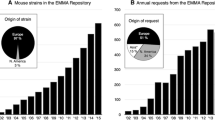Abstract
Design and production of genetically engineered mouse strains by individual research laboratories, research teams, large-scale consortia, and the biopharmaceutical industry have magnified the need for qualified personnel to identify, annotate, and validate (phenotype) these potentially new mouse models of human disease. The PATHBIO project has been recently established and funded by the European Union’s ERASMUS+ Knowledge Alliance program to address the current shortfall in formally trained personnel. A series of teaching workshops will be given by experts on anatomy, histology, embryology, imaging, and comparative pathology to increase the availability of individuals with formal training to contribute to this important niche of Europe’s biomedical research enterprise. These didactic and hands-on workshops are organized into three modules: (1) embryology, anatomy, histology, and the anatomical basis of imaging, (2) image-based phenotyping, and (3) pathology. The workshops are open to all levels of participants from recent graduates to Ph.D., M.D., and veterinary scientists. Participation is available on a competitive basis at no cost for attending. The first series of Workshop Modules was held in 2019 and these will continue for the next 2 years.
Similar content being viewed by others
References
Birling MC, Herault Y, Pavlovic G (2017) Modeling human disease in rodents by CRISPR/Cas9 genome editing. Mam Genome 28:291–301
Bogue MA, Grubb SC, Walton DO, Philip VM, Kolishovski G et al (2018) Mouse Phenome Database: an integrative database and analysis suite for curated empirical phenotype data from laboratory mice. Nucl Acids Res 46:D843–D850
Eppig JT (2017) Mouse Genome Informatics (MGI) Resource: genetic, genomic, and biological knowledgebase for the laboratory mouse. ILAR J 58:17–41
Eppig JT, Smith CL, Blake JA, Ringwald M, Kadin JA et al (2017) Mouse Genome Informatics (MGI): resources for mining mouse genetic, genomic, and biological data in support of primary and translational research. Methods Mol Biol 1488:47–73
Krupke DM, Begley DA, Sundberg JP, Richardson JE, Neuhauser SB et al (2017) The Mouse Tumor Biology Database: a comprehensive resource for mouse models of human cancer. Cancer Res 77:e67–e70
Schofield PN, Bard JB, Boniver J, Covelli V, Delvenne P et al (2004a) Pathbase: a new reference resource and database for laboratory mouse pathology. Radiat Prot Dosimetry 112:525–528
Schofield PN, Bard JB, Booth C, Boniver J, Covelli V et al (2004b) Pathbase: a database of mutant mouse pathology. Nucl Acids Res 32:D512–D515
Schofield PN, Gruenberger M, Sundberg JP (2010) Pathbase and the MPATH ontology. Community resources for mouse histopathology. Vet Pathol 47:1016–1020
Strong LC (1942) The origin of some inbred mice. Cancer Res 2:531–539
Sundberg JP, Hogan ME, King LE (1996) Normal biology and aging changes in skin and hair. In: Mohr U, et al. (eds) Pathobiology of the aging mouse. ILSI Press, Washington, DC, pp 303–323
Sundberg JP, Sundberg BA, Beamer WG (1997) Comparison of chemical carcinogen skin tumor induction efficacy in inbred, mutant, and hybrid strains of mice: morphologic variations of induced tumors and absence of a papillomavirus cocarcinogen. Mol Carcinog 20:19–32
Sundberg JP, Ward JM, HogenEsch H, Nikitin AY, Treuting PM et al (2012) Training pathologists in mouse pathology. Vet Pathol 49:393–397
Sundberg JP, Stearns TM, Joh J, Proctor M, Ingle A et al (2014) Immune status, strain background, and anatomic site of inoculation affect mouse papillomavirus (MmuPV1) induction of exophytic papillomas or endophytic trichoblastomas. PLoS ONE 9:e113582
Sundberg JP, Boyd K, Hogenesch H, Nikitin AY, Treuting PM et al (2018) Training mouse pathologists: 16th annual workshop on the pathology of mouse models of human disease. Lab Anim (NY) 47:38–40
Voigt AY, Michaud M, Tsai KY, Oh J, Sundberg JP (2019) Differential hairless mouse strain-specific susceptibility to skin cancer and sunburn. J Invest Dermatol 8:1837–1840
Acknowledgements
This work was supported by a grant from the Erasmus+ Knowledge Alliance of the Education, Audiovisual and Culture Executive Agency (EACEA) of the European Union (Reference Number 600803-EPP-1-2018-1-ES-EPPKA2). The name of the project is Precision PathoBiology for Disease Models (PATHBIO). The authors want also to thank all partners involved in the PATHBIO Consortium.
Author information
Authors and Affiliations
Corresponding author
Ethics declarations
Conflict of interest
On behalf of all authors, the corresponding author states that there is no conflict of interest.
Additional information
Publisher's Note
Springer Nature remains neutral with regard to jurisdictional claims in published maps and institutional affiliations.
Rights and permissions
About this article
Cite this article
Ruberte, J., Schofield, P.N., Brakebusch, C. et al. PATHBIO: an international training program for precision mouse phenotyping. Mamm Genome 31, 49–53 (2020). https://doi.org/10.1007/s00335-020-09829-1
Received:
Accepted:
Published:
Issue Date:
DOI: https://doi.org/10.1007/s00335-020-09829-1








